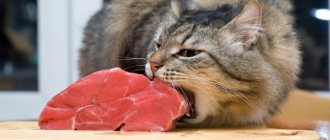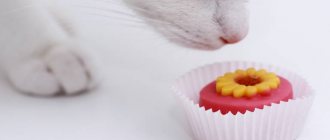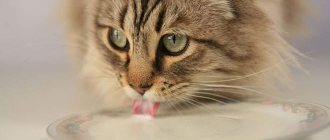Cats and chocolate - why do we say no to candy?
Common phrase: “In the end, a cat always knows what is good for it and what can harm it.” Could this be true? Why should we stop a cat from eating chocolate?
Cats have a very specific metabolism. Many foods that people eat almost every day are hazardous to their health for cats: nuts, raisins, onions, avocados... These are just a few examples. Sweets also pose a serious threat - chocolate is extremely toxic. Unfortunately, not all owners know that by offering their cat some sweets, they risk serious health complications.
So, to the question:
Can cats eat chocolate? We answer: absolutely not!
Why are cats interested in sweets?
Many owners are surprised that their cat willingly eats chocolate; they think that she likes sweet foods. In reality, the animal does not perceive sweet taste; there are no corresponding taste buds on the surface of the cat's tongue. The cat enjoys eating chocolate not because of its sweetness, but because of the fats and milk it contains.
The main reasons why cats like chocolate products:
- pleasant milky aroma of the product, enhanced by synthetic flavors;
- the delicate consistency of the sweet product due to the presence of fats in the composition;
- poor quality diet, which causes the animal to have a strong desire to consume carbohydrate foods;
- hypovitaminosis in a pet, causing a desire to receive vitamins and minerals from any food source;
- the pet’s habit of eating from hand what the owner offers, without considering the taste and quality of the product.
Why do many animals prefer this dessert?
It is known that these furry predators usually eat meat, poultry and fish fillets. Today, some owners feed them with special foods that can be purchased at pet stores, but in addition give them a taste of food prepared for people. Owners have different answers to the question of what cats like. After all, animals often give preference to products that are atypical at first glance. For example, desserts containing cocoa bean powder. These are chocolate bars and bars, candies, cookies.
This fact seems incredible. After all, cats do not have receptors responsible for the sensation of sweet taste. However, other substances that are part of desserts (proteins, amino acids, lipids of plant origin) attract pets. Can cats have chocolate? Many owners are interested in this question. It should be noted that the introduction of such a product into the diet of animals must be treated very carefully.
The effect of chocolate on a cat
Many owners, not bothering to find out whether cats can eat chocolate, treat their pets with a treat that they eat with pleasure, thereby causing great harm to their bodies. There are several reasons why cats should not eat chocolate:
- Theobromine is an alkaloid present in chocolate products. The cat's body perceives it as a strong poison. Symptoms of intoxication are increased heart rate, irregular heart rhythm, the animal being in an excited state, and in severe cases, diarrhea and vomiting. A poisoned pet should be taken to a veterinarian immediately.
- Sugar is a poison that the animal does not feel. A cat in chocolate is attracted to milk protein, but along with this healthy component, it eats a large amount of harmful sugar.
- Simple carbohydrates that are completely unnecessary for a cat at home, since it wastes little energy. Chocolate is a high-carbohydrate product that leads to metabolic disorders and obesity in your pet.
- Diabetes is a consequence of regular consumption of chocolate sweets. Insulin deficiency develops in the animal's body, leading to disruption of protein metabolism. She becomes lethargic and constantly thirsty.
In what form should you give sweets?
If the owner still plans to periodically pamper the cat with sweets, veterinarians recommend choosing the least dangerous foods for the animal’s body as dessert.
So, what sweets do breeders observe to be of increased interest to pets: ice cream, lollipops, condensed milk, sweets, sweet baked goods, cookies, fruits and berries. Now let's look at all these products in order!
How to give chocolate to cats
Even knowledgeable owners admit that sometimes they allow their pet to eat a little chocolate, because they think that a small amount of treats will not provoke negative consequences. The animal’s well-being will not immediately worsen because of a small piece of chocolate, but harm will be done to the body, and it will manifest itself later.
A serving of a sweet product that leads to liver failure in a cat and death is 30–35 g.
And even the sweet treats sold in pet stores are not as harmless as the manufacturers claim. And they are also completely useless, because she does not feel their sweet taste.
Which chocolate to give is more or less safe - white milk chocolate that does not contain cocoa. But it is also given in minimal quantities, because it also contains sugar.
If, despite the ban, the owner decides to treat his pet to a chocolate bar with cocoa, then he must take into account the following rules:
- You should remember the maximum permissible dose of theobromine, calculated based on the weight of the animal. The danger is represented by an amount of alkaloid exceeding 20 mg per 0.5 kg of cat’s body weight.
- You cannot treat the animal regularly. The harm lies not only in sugar and theobromine, but also in cocoa. The absorption of this plant product in the cat’s body is long: 2 times longer than the digestion time of meat. Sweets consumed daily simply do not have time to be absorbed, causing disturbances in the digestive tract.
- Is it possible to give cats a safe portion at a time - veterinarians say it’s not worth it. For better absorption, it is advisable to break the piece of chocolate into several servings.
- Chocolate is harmful to cats because it causes dehydration. Therefore, after treating your pet with a treat, you should immediately offer him water. It will not only relieve thirst, but also improve the absorption of the product.
- It is strictly forbidden to exceed the permissible dosage.
Useful tips
Ice cream is a favorite treat for cats, especially in the summer season. But those products that are sold in the store cannot be given to pets due to their high sugar content. But you can make ice cream for your pet yourself, using only high-quality and natural ingredients without sugar.
Some owners are sure that nothing bad will happen to the animal from condensed milk. Actually this is not true. After eating this product, the cat may experience nausea, vomiting, diarrhea, loss of strength - all these are consequences of severe intoxication of the body.
If your cat is drawn to sweets and manages to steal them, then they need to be put in a place where the animal cannot get into.
To learn how sugar is harmful to cats, watch the following video.
Symptoms of chocolate poisoning
The lethal amount of theobromine for a cat is 200 mg.
A cat weighing 4.5 kg will be seriously harmed if she eats:
For kittens, the indicated portions are reduced according to body weight.
Signs of poisoning:
- excited, nervous state;
- lethargy;
- dehydration;
- excessive urination;
- heart rhythm disturbance;
- convulsive and convulsive states;
- nausea, urge to vomit;
- diarrhea;
- rapid breathing;
- increased blood pressure.
In case of serious poisoning and lack of veterinary care, the animal falls into a coma and dies.
If the cat is taken to the veterinarian within an hour from the moment of poisoning, and the chocolate has not yet had time to be absorbed, then the specialist rinses the stomach and gives the tailed patient activated charcoal.
If more than an hour has passed, the pet remains in a hospital setting and is connected to a ventilator and heart rate monitoring. The animal's urine and blood are taken for analysis to confirm intoxication.
This treat is an extremely harmful product for cats. Owners should not risk the health and life of their pets. The most common consequence is diabetes, but the animal can also develop pancreatitis due to fats and sugar. A severe case can result in death.
Animals are often endowed with specific tastes in food, and owners, without thinking about whether cats can eat chocolate, indulge their pets.
Sometimes a cat owner, consuming chocolate, considers it his duty to share the treat with his furry friend, not suspecting that it may turn out to be poisonous for the animal.
Cats do not perceive sweet taste. The cat eats chocolate only because it contains the pleasant smell of milk. By eating a sweet treat, an animal can become poisoned or develop obesity and diabetes.
Usually cats refuse such treats, but there are situations when owners do not know whether cats can have chocolate, but cats like it.
The following reasons cause increased interest in chocolate:
- the presence of synthetic flavors;
- hypovitaminosis, which encourages the cat to obtain vitamins in any way;
- having the habit of eating from your hands without tasting the food;
- unstable nutrition, causing a desire to eat carbohydrate foods.
Chocolate contains caffeine, methylxanthine, and theobromine, which cats cannot digest. When they enter a cat’s body, they cause dehydration, increased contraction of the heart muscle, and problems with the stomach and intestinal tract. Knowing these facts, it is worth thinking about whether your cat can be given chocolate.
Signs of intoxication
Not all owners adhere to such rules. Veterinarians say that they often encounter intoxication that occurs after eating chocolate. Poisoning in cats associated with the consumption of this dessert most often occurs on holidays, when the owners have a large amount of candy on their table. How does the pathology manifest itself? Intoxication can be diagnosed if the following signs are present:
Only a specialist can diagnose and treat the disease. Therefore, if the owner suspects that the pet has been poisoned by chocolate, he should take the pet to the veterinarian as soon as possible. You should tell the doctor how much dessert the cat ate. Sometimes the doctor advises to alleviate the animal’s condition by gastric lavage. For this, water mixed with crushed activated carbon is used.
Of course, all owners know what the cats living in their home love. However, before pampering your pet with any treat, you need to find out whether this food is as safe as it seems at first glance. Particular attention should be paid to the health of pregnant and lactating animals. The body of older animals and young animals is also sensitive.
The answer to the question of whether cats can have chocolate is very ambiguous. It all depends on the amount of dessert, the frequency of its use and the characteristics of the pet.
About the rules
It would be right if, before getting a pet, you study the future diet and the question of whether cats can eat chocolate.
It is important, when treating your cat with a chocolate treat, to follow some rules that will help protect the animal:
- You cannot accustom him to frequent treats, since the cat’s digestive tract takes a long time to digest this product.
- Before giving your pet a treat, you should think about whether cats can eat chocolate and calculate its permissible amount, knowing that 25 - 30 g of treats is considered a dangerous dose for an adult cat.
- Keep in mind that it will be safer to divide the amount of acceptable chocolate into several doses.
- Be sure to make sure your cat has enough to drink on sweet days.
Attention! You cannot increase the norm, since the cat eats chocolate without understanding the taste, and overeating can put it in mortal danger.
Deadly danger
When a cat is poisoned by chocolate, the following symptoms appear:
- the cat makes loud noises;
- the appearance of muscle cramps or tremors;
- consumption of water in large quantities;
- rapid breathing;
- increased blood pressure;
- frequent urge to urinate;
- the appearance of nausea, vomiting and diarrhea.
Measures should be taken immediately, otherwise the cat’s liver may fail, which is fatal. The best way to help your pet is to call a veterinarian. Before his arrival, you can give your cat water with dissolved activated carbon to drink.
Important! Within an hour, provide the animal with medical assistance, which consists of gastric lavage and drinking plenty of fluids!
If more time has passed since the chocolate was consumed, then the cat will need inpatient medical care, where it will be connected to a ventilator, the functioning of the cardiac system will be monitored, and the level of intoxication will be monitored.
What's next for the cat?
Cats are very sensitive to the emotions of their owners. In addition to controlling emotions, it is best for the owner to keep the pet in a cool, calm and quiet place so that the symptoms of chocolate poisoning do not worsen.
Upon admission to the clinic, the doctor will take tests from the cat and prescribe the necessary therapy. The need for further testing and treatment options will depend on the animal's health and weight, as well as the type and amount of chocolate eaten. Your veterinarian may even encourage your cat to vomit to prevent toxins from working in her digestive system.
Can cats have sweets?
Very often, cat owners say that their cat loves sweets: ice cream, cookies, chocolate literally drive their four-legged pets crazy.
Well, how can you not pamper your pet? Unfortunately, in their desire to please, owners do not think about whether cats can have sweets. Observing the pleasure with which cats eat sweets, it begins to seem that they have a sweet tooth, but this opinion is wrong. Our four-legged pets, due to the absence of the Tas1r2 gene in their DNA, do not have receptors on the tongue that are needed to distinguish tastes. Cats are carnivores by nature; they need proteins, not carbohydrates. Therefore, it is not necessary to taste sweets.
The question immediately arises, why does the cat eat sweets with such pleasure? The reason is that this or that sweet contains proteins, amino acids, and vegetable fats that attract cats with their taste. Therefore, when it seems to you that cats love sweets, in fact they simply taste the components that make up the treat you offer. Thus, we have found out that giving sweets to a cat is simply useless, it does not bring any benefit, but why can’t you just pamper your pet?
Based on the fact that sweet taste is inaccessible to cats, zoologists have come to the following conclusions: due to the fact that cats do not taste it, they cannot correctly determine exactly how much sugar they consume. The cat calculates the amount of those components that it senses that is safe for its body, and carbohydrates that are harmful to it penetrate the body unnoticed, often leading to serious poisoning. This is why giving sweets is not only useless, but also harmful.
What kind of problems can you encounter when pampering your pet? Let's look at the example of the most common delicacies and what danger each of them poses. Cats can't have sweets, but can a small piece of chocolate really do any harm? Cocoa beans contain large amounts of a special substance, theobromine, which is poisonous to cats. Even a small piece of chocolate in your opinion can lead to increased heart rate and increased blood pressure, severe stimulation of the nervous system, even leading to convulsions and seizures. In large doses, this alkaloid causes death.
The next treat that owners love to pamper cats with, even knowing that sweets are not allowed, is ice cream. The cat eats it with pleasure, primarily not as a sweet, but as a dairy product, and is not even aware of the sugar it contains. Thus, sugar enters the cat’s body unnoticed by it; it does not control its quantity, so an overdose can occur and, as a result, serious poisoning with vomiting and diarrhea. In addition, sugar also causes dental disease.
Special attention should be paid to the question of whether it is possible to give sweets to kittens, sick, aging, pregnant and lactating cats. Sweets pose a particular risk to these groups of cats. They have a weakened body, so even one candy can provoke vomiting, diarrhea, itching, hair loss, blurred vision, and many cats have “running” eyes.
Remember that after a sweet menu, your pet may have a completely unsweetened life. If you want to pamper your pet with something tasty, you can buy special cat treats at the pet store for cats, which will not only delight your mustachioed gourmet with its taste, but will also take care of his health.
Sweets are neither necessary nor healthy for a cat. Moreover, the cat simply does not distinguish this taste.
Sweets and cat diseases
The first thing that can happen to a pet when eating sweets is a decrease in immunity and the development of many serious diseases.
Immune defense disorders
Even a small piece of chocolate can cause severe poisoning in a cat. And if everything seems to have gone well, the consequences may be distant.
The immune system was damaged in any case. And against the background of this disorder, allergic reactions may occur, diseases of the oral cavity may appear, numerous redness, ulcers and sores form on the gums, itching of the skin, hair loss begins and the development of alopenia.
Chocolate, sweets, and cakes can also cause a deterioration in a cat’s vision, including blindness, as well as cause diarrhea and vomiting, and increased salivation.
Decreased immunity undermines the cat's body's defenses. The animal becomes susceptible to colds and viral diseases, otitis media and conjunctivitis, fungal infections of any organs.
The digestive system also suffers, the animal develops a false feeling of fullness, and the digestibility of animal protein deteriorates. Oxygen saturation of tissues decreases, and the aging process of the entire organism as a whole accelerates.
Urolithiasis disease
Cats' kidneys are the first to suffer when they eat sweets. Due to intensive work (after all, this is a purification system that unsuccessfully tries to remove harmful products from the body), they significantly increase in size.
The animal's organs are subject to wear and tear, and the acid-base balance is disturbed. And sweets can lead to this just as much as salty foods.
Depending on the type of sweets, either excessive oxidation or alkalization of the body occurs, which in any case leads to the development of kidney failure. Urolithiasis, when eating sweets in large quantities, occurs even in cats that do not have a predisposition to it.
Diabetes
A cat's body is not designed to process large amounts of glucose. Insulin begins to be produced in concentrations that greatly exceed the permissible norm in the blood.
The cat quickly loses sensitivity to this substance, the level of glucose in both the blood and the animal’s urine always remains at high levels, diabetes mellitus quickly develops and the pet becomes a hostage to the “sugar” diet.
Excess carbohydrates
A person often eats a piece of chocolate when he needs to quickly increase energy levels, relieve fatigue, improve the ability to think and make decisions instantly, during heavy mental or physical work. And after even a small dose of chocolate, you feel a surge of strength and acceleration of thought.
By offering the same piece of treat to a pet, the owner causes him great harm. Especially for a cat in a small apartment, where she does not have the opportunity to move enough. All excess carbohydrates, even if they do not lead to serious illnesses, will certainly be stored in the form of excess fat.
Nature provides for the consumption of large quantities of proteins by predators, which is the key to their health and longevity. Carbohydrates are needed in minimal quantities; exceeding the required level means dooming your pet to illness and early death.
Does your cat have a sweet tooth?
Of course, the best treat for a cat is aromatic fried chicken or baked turkey. But what about the traditional sweets for people? Do our furry friends like them? Let's start with the fact that cats, in principle, cannot sense sweet taste. They don’t have such receptors on their tongue. In humans, everything is completely different: our tongue is divided into several zones, each of which is “responsible” for its own flavor. We feel the same sweetness, for example, with the tip of our tongue. That is why it is so pleasant when ice cream melts in your mouth, because all the sweetness is concentrated exactly where it is needed... But cats are able to distinguish a lot of flavor shades of meat food. Their world of taste is completely different from the human one. On the sides of the cat's tongue, on its tip and on the bottom, there are more than two hundred and fifty taste buds, each of which contains from forty to forty thousand receptors. Cats easily distinguish between sour and bitter tastes, and the tip of their tongue is “responsible” for recognizing salt. But the taste of sugar remains a mystery to them. A cat can drink sweet water and not feel the problem. However, there is a problem with this - the cat not only does not taste sweets, but is also unable to digest sucrose. In other words, if she overeats sweets, she will feel very bad. Some cats love yoghurt, ice cream, condensed milk and even chocolate. Under no circumstances should you pamper them with such products. The fact is that the cat is not attracted to the sweet taste. She just needs amino acids, which are found in large quantities in these products. It is thanks to them that protein is formed in the body of cats. In addition, such treats contain a lot of fat, which is also necessary for cats. That’s why our tailed pets stick their curious little faces into a yogurt cup. Or they pounce on a piece of milk chocolate. Yet sugar is extremely harmful to cats. It not only upsets the entire digestive system, but also causes caries and other unpleasant diseases in animals. One of the most terrible diseases associated with excess sugar consumption is diabetes. And chocolate is completely poisonous to cats. It contains the substance theobromine or methylxanthine, an excess of which can lead to the death of the animal. Moreover, the dosage is individual for everyone. Theobromine causes increased heart rate, as well as vomiting, diarrhea and even stomach ulcers. In addition, by negatively affecting the nervous system, it can lead to convulsions and seizures. Therefore, veterinarians not only do not recommend giving cats chocolate, but also insist on urgent hospitalization if the animal accidentally ate candy or chocolate chip cookies. If you really want to pamper your beloved cat, it is better to buy special cat treats at the pet store. They will please the cat and keep its digestive system healthy. Or you can cook something delicious yourself, and your kitty will definitely purr “thank you” to you. But even better, just feed her high-quality cat food. Then you can certainly be sure that your pet will always be healthy and cheerful.










